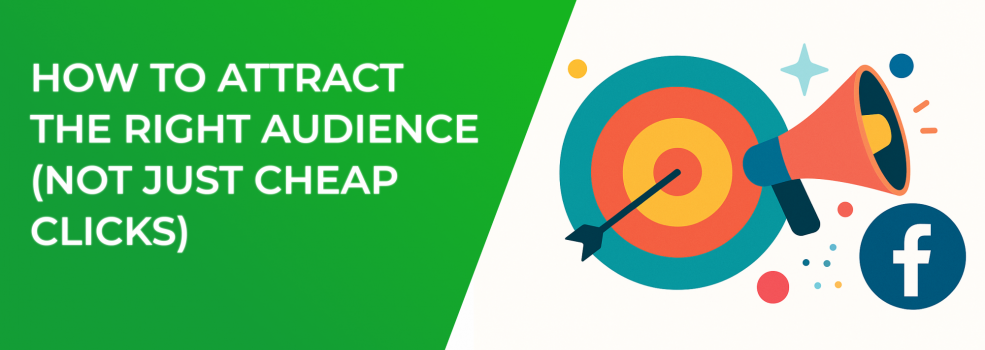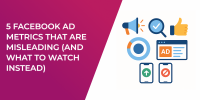Ever stared at Facebook Ads Manager celebrating a $0.20 CPC and still wondered why nobody is buying? Cheap clicks look impressive in a report, but low-intent traffic rarely turns into revenue. The real prize is quality reach, genuine engagement, and measurable conversions that keep finance and sales smiling.
Below is a practical playbook you can start using today to swap vanity metrics for meaningful growth.
1. Stop Chasing Bargain CPCs and Start Tracking Business Outcomes
Clicks alone don’t pay the bills — conversions do.
Many advertisers fixate on average cost per click Facebook because it’s easy to measure, yet it says little about profit. Shift your scorecard:
-
Track Facebook conversion events (purchases, booked calls, demo requests) instead of surface-level clicks.
-
Benchmark against industry Facebook ads results and your own lifetime-value targets rather than this-week CPA.
-
Compare funnel performance to fresh Facebook ads benchmarks so you know if “cheap” is actually “effective.”
-
Review Facebook ad ROI and cost per action Facebook weekly to be sure spend lines up with revenue goals.
When you measure business outcomes first, it becomes obvious which campaigns look good but secretly bleed cash. Still wrestling with silent prospects? Dive into our troubleshooting checklist in Facebook Ads Not Converting: How to Fix It for quick wins that turn clicks into customers.
2. Build a Customer-First Targeting Blueprint
The tighter your audience definition, the higher your intent and the easier it is to turn traffic into sales.
Layer your audiences to move from broad reach to laser precision.
Unfocused audiences invite low-quality traffic. Tighten your aim with this checklist and note where you need improvements:
-
Create buyer personas from Audience Insights and CRM data.
-
Install and verify the Facebook pixel on every key page; test with Pixel Helper for proper events.
-
Launch retargeting ads for site visitors, cart abandoners, and video viewers.
-
Build lookalike audiences based on paying customers, not random page-likes.
-
Drop or restructure ad sets stuck in learning-limited Facebook ads for more than seven days.
-
Experiment with advantage campaign budget to let the algorithm fund your best segments automatically.
A sharper audience may lift Facebook CPM, yet higher intent usually boosts CTR Facebook and Facebook ad conversion rate enough to offset the cost. For a deeper walk-through of interest, behavior, and demographic layers, see Facebook Ad Targeting 101: How to Reach the Right Audience.
3. Nail the Message-Market Match Within the First Three Seconds
Your ad’s opening seconds decide whether the right people stop scrolling.
Great creative attracts buyers and repels everyone else:
-
Headline: state a pain your prospects actually feel (“Hiring managers drowning in junk résumés?”).
-
Visual: show the promised after-state rather than bland stock imagery.
-
Copy: write Facebook ad copy that promises outcomes (“Schedule a demo today”) instead of hollow verbs (“Learn more”).
-
Test dynamic creative Facebook to mix images and text until you find a winner.
A clear hook filters curiosity clicks, improving average click-through rate on Facebook ads while protecting budget. Need headline inspiration? Our copywriting playbook Crafting Compelling Facebook Ads Copy That Converts breaks down proven hooks you can swipe today.
4. Let Campaign Budget Optimization Work Smarter Than You Do
Automation can stretch every ad dollar as long as you add guardrails.
Manually splitting budget can starve your best performers. Turn on campaign budget optimization and set simple Ads Manager rules:
Review results every 48 hours so you remain the strategist, not the spreadsheet jockey. If you’d like even more rule ideas, check out How to Use Automated Rules to Improve Facebook Campaign Efficiency for step-by-step setups.
5. Track the Whole Funnel Instead of Just the Ad Platform
Even a perfect ad can’t fix a broken landing page.
Close your data loop:
-
Pass UTM parameters into your CRM and marketing-automation tool.
-
Tie first click to closed-won revenue so you can run real ads analysis instead of guesswork.
-
Set alerts when qualified-demo volume drops 10% week-over-week even if ad-impressions Facebook appear healthy.
-
Compare on-site behavior to external Facebook engagement-rate reports to isolate friction points fast.
Once you see every touchpoint, sudden drops in Facebook ad reach or Facebook ad CPA are far easier to diagnose. Mapping clicks to closed-won revenue takes a solid funnel plan—our guide Facebook Ads Funnel Strategy: From Audience Identification to Conversion shows every stage in detail.
6. Iterate Relentlessly With Facebook Ad Optimization Best Practices
Optimization is a daily habit, not a one-time project.
Keep this punch list handy and revisit it each Monday:
-
Use Facebook ads split-test (A/B) to tweak one variable at a time.
-
Rotate fresh Facebook ad creative every one to two weeks to avoid burnout.
-
Watch Facebook ad frequency; anything over five can spike Facebook CPM and annoy prospects.
-
Run a quarterly Facebook ads audit covering pixel health, audience overlap, placement exclusions, and trend lines for Facebook ad CTR.
-
Analyze seasonality and cohort LTV during deep-dive reviews to spot new growth windows.
Finally, keep your tests efficient by exiting the learning phase faster with tips from How to Finish the Facebook Learning Phase Quickly.
Key Takeaways
-
Quality trumps quantity on Facebook.
-
Track business outcomes first, not bargain CPCs.
-
Layer intent-rich audiences and pair them with pain-specific creatives.
-
Automate budgets but supervise with clear rules.
-
Connect ad data to the whole funnel so you can scale what works and cut what doesn’t.

